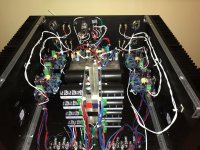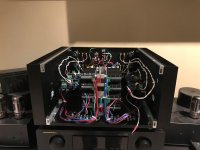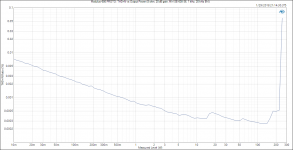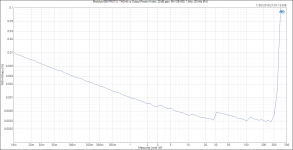Yes, it does remove the low-frequency boost from the LXmini speakers. It also adds a 20Hz HP filter which eases excursion a bit further and also helps phase-matching with the sub-woofers.
The sub-woofers themselves are a simple, closed-box setup using Peerless 830668 drivers. So, very easy to add on to the existing LXmini scheme with minimal cost. Much less than the LXmini+2 dipole setup.
Dave.
So it is a HP filter,... okay. I just know it sounds awesome 👍
In this case, the 20 Hz HP filter is a subsonic filter which limits the excursion on the sub driver on recordings with high subsonic content. This filter is part of the DSP filter for the LXmini + subwoofer setup. You wouldn't want a 400 Hz HP filter on a circuit feeding a subwoofer.
Tom
Tom
In this case, the 20 Hz HP filter is a subsonic filter which limits the excursion on the sub driver on recordings with high subsonic content. This filter is part of the DSP filter for the LXmini + subwoofer setup. You wouldn't want a 400 Hz HP filter on a circuit feeding a subwoofer.
Tom
No, this filter is not on the subwoofer channel, but on the LXmini main (5") driver itself. The LXmini+ subwoofer has no electrical HP filter.
If interested in more details, I suggest for users to check the thread at the OPLUG, so the thread here is not further jacked.
ORION/PLUTO/LX... Users Group • View topic - LXmini subwoofer add-on
Dave.
Dave: Not really Jacking the thread as a lot of Mod86 have been built to drive LXminis. I still wonder if I shouldn't have build a pair instead of trying to make apogees work in a room that is stacked against them. But it does seem that Mod86+Lxmini is one of those matches made in the residence of $DEITY.
My bad. I assumed it was on the sub channel. I still think the HP filter makes sense, though.
Tom
No problem. I need to update the first post (fifth frequency plot) in the OPLUG thread to reflect the change I made later in the evolution. In that plot you'll see the main speaker response extends to 10Hz flat, but it's no longer configured that way.
Dave.
Great amps Tom;
Listening to four channels of a soon to be six channel amp. The last two channels are built and tested; I am just conducting a listening test on the first four with a passively bi-amped system.
Dead quiet, fast and resolving. Very very clean.
Kudos; very well done!


Matt
Listening to four channels of a soon to be six channel amp. The last two channels are built and tested; I am just conducting a listening test on the first four with a passively bi-amped system.
Dead quiet, fast and resolving. Very very clean.
Kudos; very well done!
Matt
Attachments
Ok, so maybe I'm biased, but I think those of you who want more power have something to look forward to.
Spinning some Dire Straits, Cream, Eric Clapton, The Eagles, et al. on the MOD686. Mono for now as I only have one channel built. Sounds amazing - like a Modulus amp only with more power.
Gain: +20 dB
THD+N: 0.00026 % (140 W @ 8 Ω)
THD+N: 0.00029 % (260 W @ 4 Ω)
Onset of clipping: 0.0005 % THD+N @ 220 W (8 Ω)
Onset of clipping: 0.070 % THD+N @ 380 W (4 Ω)
Noise: 15 uV RMS (A-weighted, 20Hz-20kHz)
Build cost: $300/channel + power supply, connectors, etc.
Teaser plots attached. I expect to open for pre-orders over the weekend.
I have decided to take the plunge and offer boards that have all the SMD components populated as well as fully assembled modules. I will not be offering bare boards.
I can offer a better product with broader appeal by dropping the bare boards and instead focusing my efforts on lowering the cost of the assembled boards.
My boards will be assembled in Northeast Calgary at western wages and western working conditions.
Tom
Spinning some Dire Straits, Cream, Eric Clapton, The Eagles, et al. on the MOD686. Mono for now as I only have one channel built. Sounds amazing - like a Modulus amp only with more power.
Gain: +20 dB
THD+N: 0.00026 % (140 W @ 8 Ω)
THD+N: 0.00029 % (260 W @ 4 Ω)
Onset of clipping: 0.0005 % THD+N @ 220 W (8 Ω)
Onset of clipping: 0.070 % THD+N @ 380 W (4 Ω)
Noise: 15 uV RMS (A-weighted, 20Hz-20kHz)
Build cost: $300/channel + power supply, connectors, etc.
Teaser plots attached. I expect to open for pre-orders over the weekend.
I have decided to take the plunge and offer boards that have all the SMD components populated as well as fully assembled modules. I will not be offering bare boards.
I can offer a better product with broader appeal by dropping the bare boards and instead focusing my efforts on lowering the cost of the assembled boards.
My boards will be assembled in Northeast Calgary at western wages and western working conditions.
Tom
Attachments
Great news on the Modulus 686. Will you be starting a new thread dedicated to it?
Yeah. I'll start a thread in the Vendor's Bazar over the weekend.
What size heat sink are you running for a single board? Would a Disspante 4U chassis have enough cooling capacity for a stereo build running at 4Ω?
I'm using a 0.4 K/W heat sink that I bought as scrap aluminum (at scrap aluminum cost) many years ago in Copenhagen.
I need to look at the Dissipante heat sink specs. 4U sounds about right.
If you lower the supply voltage to ±28 V, you can probably get away with the 3U. You'd get around 150 W in that case. That'd be a nice safe and sane build for those who'd like more power than the MOD86 delivers but don't need the 200+ W.
Is it possible to adjust the gain to 26db? I want to be able to bi-amp alongside my bridged Para 86 amps that are 26db.
Absolutely. I'll build the boards with the default 26 dB gain. Those who want the slightly lower noise floor can pluck a resistor off the board and reduce the gain to 20 dB.
The gain is adjusted by changing one resistor. This can be done without impacting amplifier stability. It does impact the amplifier noise floor, though, so as the gain is increased, the THD+N gets a bit worse. Figure a 3 dB change in gain -> 3 dB change in THD+N.
The MOD686 has differential (balanced/XLR) input. It can be run single-ended (unbalanced/RCA) as well. I took the lessons learned from the MOD86 and applied them to the '686. Thus, the '686 will start up cleanly (no plop) even with an unbalanced input, unlike the MOD86 where there is a small plop from the input bias current of the THAT1200.
Tom
Last edited:
I need to look at the Dissipante heat sink specs. 4U sounds about right.
If the board dimensions aren't locked in yet, it would be nice if the mounting pattern matched the pre-drilled UMS-spec heatsinks sold in the DIYAudio store. Not a requirement, but would be a nice to have. Assuming its possible to mount the boards flat against the heatsinks.
...Teaser plots attached...
Impressing graphs as always, inviting friends for a party is this then the perfect LXmini drive
If the board dimensions aren't locked in yet, it would be nice if the mounting pattern matched the pre-drilled UMS-spec heatsinks sold in the DIYAudio store.
I have 100 boards coming out of the FAB in about two weeks, so the holes aren't moving.
The mounting hole pattern will not match the UMS-spec. "Universal" anything in my experience means "fits nothing". It's a nice idea in theory, but in practice I think it's of limited value - maybe with the exception of power supply boards and other "in the middle of the chassis" type circuits.
I will have some mounting brackets made that will allow you to just bolt the bracket to the heat sink. The bracket will have threaded standoffs for the mounting screws and threaded studs for the LM3886es. I'll sell the bracket separately for those interested.
Those who prefer to go without the bracket can use the Keystone #4332 brackets, drill up the holes in the PCB to fit a US #6 machine screw and go that route.
The 686 seems perfectly capable of destroying the drivers of an LXmini if that's what you're looking for. Maybe Tom will test drive when he has more working channels, but the '686's output power would seem beyond the needs of the LXmini drivers.
That's a fair observation. The Modulus-286 (MONO) would be a better fit for the LXmini, at least from an engineering perspective. It provides 50 W into 8 Ω and 100 W into 4 Ω, which lines up well with the driver power ratings as I recall. From a psychological perspective, some may find comfort in the ~6 dB of headroom the MOD686 provides over the MOD286-MONO. That peace of mind has value too.
The MOD286-MONO is $40-50 less per channel than the MOD686.
Does the MOD286 have the MOD86 small plop feature?
Right now it does. I can remove that plop from the '286 pretty easily, though. All that's required is a small BOM change. I think you save a buck or two that way too. I'll need to double-check the schematic and run a simulation or two, but I think you can just swap out the OPA1612 for something low-noise with a FET input (OPA1642, for example) and have the plop go away.
The plop will remain on the MOD86. Blame the input bias current of the THAT1200. You can reduce the (already low) plop dramatically by soldering 10 kΩ across the RCA input connector.
There is no plop when using differential connections, even on the MOD86.
If I end up making an Rev. 3.0 of the MOD86 (and I am not currently thinking to do that), I will remove the plop if I can. It all depends on which parts I can find in leaded packages as I am committed to keeping the MOD86 an all-leaded build if at all possible.
Tom
- Home
- Amplifiers
- Chip Amps
- Modulus-86 build thread



